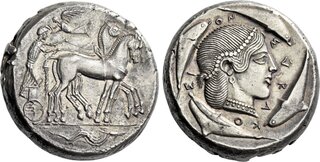| Numismatica Ars Classica > Auction 146 | Auction date: 8 May 2024 |
| Lot number: 2096 Price realized: This lot is for sale in an upcoming auction - Bid on this lot  | Show similar lots on CoinArchives Find similar lots in upcoming auctions on |
| Lot description: Syracuse. Tetradrachm circa 460, AR 25 mm, 17.30 g. Slow quadriga r. on exergual line, driven by charioteer standing, holding reins in both hands; above, Nike flying l. and crowning charioteer; in exergue, sea-serpent r. Rev. ΣΥΡΑ – ΚΟ – ΣΙ – ΟΝ Head of the nymph Arethusa r., wearing diadem of beads, circular earring, and necklace of beads; around, four dolphins. BMC Sicily - cf. 154, 68 (legend differently subdivided). SNG ANS 134–136. Boehringer 440. AMB 435 (this obverse die). de Luynes 1171. Boston, MFA 362 (this obverse die). Perfectly struck on very fresh metal, wonderful light iridescent tone. Virtually as struck and almost Fdc Ex NFA 20, 1988, 630 and NAC Spring 2020, 150 sales. The tetradrachms of Syracuse underwent a subtle stylistic evolution in the second quarter of the 5th Century B.C.; the compact Arethusa head of the massive issue of the late 480s was transformed into one with a longer, thinner profile. A defining design element on the tetradrachms of this period is the ketos (pistrix), a sea-serpent that appears beneath the chariot scene. It was introduced during the reign of Hieron (478-466 B.C.) and outlasted the Deinomenid house, for it also was used under the democratic government that followed. The meaning of this sea-serpent is debated, though it is often thought to represent Syracusan naval power following the defeat of the Etruscan fleet off the coast of Cumae in 474 B.C. This tetradrachm was struck with masterful dies. The head of the divinity is serene and ideally proportioned, with her hair neatly arranged; her diadem curves over her ear and captures the end of her hair, which is pulled up and contained. Her bust is framed by the pearls or beads of her diadem and her necklace, which offer a contrasting texture to that of her hair and face. Equally impressive is the great size of the dolphins and horses, which give them a robust, lively appearance. Though the treatment of the chariot and Arethusa are distinctive in their details and composition, the 'severity' of the style is reminiscent of the 'Demaretion Master' issues, which belong to the early part of this period. The transitional window to which this coin belongs was regrettably short, and soon afterward the portraits often become ill-proportioned, brutish and generally unappealing. Fortunately, by 450 B.C. or soon after, Syracusan coinage entered another inventive phase defined by signed masterpieces with varied treatments of Arethusa and innovative presentations of the quadriga scene. Estimate: 20000 CHF |  |



